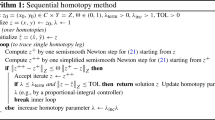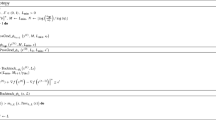Abstract
Probability-one homotopy methods are a class of algorithms for solving nonlinear systems of equations that are accurate, robust, and converge from an arbitrary starting point almost surely. These new globally convergent homotopy techniques have been successfully applied to solve Brouwer fixed point problems, polynomial systems of equations, constrained and unconstrained optimization problems, discretizations of nonlinear two-point boundary value problems based on shooting, finite differences, collocation, and finite elements, and finite difference, collocation, and Galerkin approximations to nonlinear partial differential equations. This paper introduces, in a tutorial fashion, the theory of globally convergent homotopy algorithms, deseribes some computer algorithms and mathematical software, and presents several nontrivial engineering applications.
Similar content being viewed by others
References
Allgower, E. and Georg, K., ‘Simplicial and continuation methods for approximating fixed points’,SIAM Rev. 22, 1980, 28–85.
Barthelemy, J.-F. M. and Riley, M. F., ‘Improved multi-level optimization approach for the design of complex engineering system’,AIAA J. 26, 1988, 353–360.
Bertsekas, D. P., Constrained Optimization and Lagrange Multiplier Methods. Academic Press, New York, 1982.
Billups S. C., An augmented Jacobian matrix algorithm for tracking homotopy zero curves, MS Thesis. Dept. of Computer Sci., VPI & SU, Blacksburg, VA, Sept., 1985.
Chow, S. N., Mallet-Paret, J., and Yorke, J. A., ‘Finding zeros of maps: Homotopy methods that are constructive with probability one’,Math. Comput. 32, 1978, 887–899.
deBoor, C., A Practical Guide to Splines. Springer-Verlag, New York, 1978.
Dennis, J. E., and Schnabel, R. Numerical Methods for Unconstrained Optimization and Nonlinear Equations. Prentice-Hall, Englewood Cliffs, NJ, 1983.
Ellis, G. H. and Watson, L. T., ‘A parallel algorithm for simple roots of polynomials’,Comput. Math. Appl. 11, 1984, 107–121.
Eringen, A. C., ‘Simple microfluids’,Int. J. Engng. Sci. 2, 1964, 205–217.
Eringen, A. C., ‘Theory of micropolar fluids’,J. Math. Mech. 16, 1966, 1–18.
Heruska, M. W., Watson, L. T., and Sankara, K. K., ‘Micropolar flow past a porous stretching sheet’,Comput. & Fluids 14, 1986, 117–129.
Kamat, M. P., Watson, L. T., and Venkayya, V. B., ‘A quasi-Newton versus a homotopy method for nonlinear structural analysis’,Comput. & Structures 17, 1983, 579–585.
Keller, H. B., Numerical Solution of Two-point Boundary Value Problems, Society for Industrial and Applied Mathematics, Philadelphia, 1976.
Kreisselmeier, G. and Steinhauser, R., ‘Systematic control design by optimizing a vector performance index’. Proc. IFAC Symp. on Computer Aided Design of Control Systems. Zurich. Switzerland. 1979, pp. 113–117.
Kubicek, M., ‘Dependence of solutions of nonlinear systems on a parameter’.ACM Trans. Math. Software 2, 1976, 98–107.
Kumar, S. K., Thacker, W. I., and Watson, L. T., ‘Magnetohydrodynamic flow and heat transfer about a rotating disk with suction and injection at the disk surface’,Comput. & Fluids 16, 1988, 183–193.
Kumar, S. K., Thacker, W. I., and Watson, L. T., ‘Magnetohydrodynamic flow past a porous rotating disk in a circular magnetic field’,Internat. J. Numr. Methods Fluids 8, 1988, 659–669.
Kumar, S. K., Thacker, W. I., and Watson, L. T., ‘Magnetohydrodynamic flow between a solid rotating disk and a porous stationary disk’,Appl. Math. Modelling 13, 1989, 494–500.
Kumar, S. K., Thacker, W. I., and Watson, L. T., ‘Rotating magnetohydrodynamic flow about a stationary disk in a circular magnetic field’,Comput. Math. Appl. 17, 1989, 1435–1439.
Kwok, H. H., Kamat, M. P., and Watson, L. T., ‘Location of stable and unstable equilibrium configurations using a model trust region quasi-Newton method and tunnelling’,Comput. & Structures 21, 1985, 909–916.
Mangasarian, O. L., ‘Equivalence of the complementarity problem to a system of nonlinear equations’,SIAM J. Appl. Math. 31, 1976, 89–92.
Mejia, R., ‘CONKUB: A conversational path-follower for systems of nonlinear equations’,J. Comput. Phys. 63, 1986, 67–84.
Moré, J. J. Garbow, B. S., and Hillstrom, K.E., User Guide for MINPACK-1, ANL-80-74, Argonne National Laboratory, 1980.
Morgan, A. P., ‘A transformation to avoid solutions at infinity for polynomial systems’,Appl. Math. Comput. 18, 1986, 77–86.
Morgan, A. P., ‘A homotopy for solving polynomial systems’,Appl. Math. Comput. 18, 1986, 87–92.
Morgan, A. P., Solving Polynomial Systems Using Continuation for Engineering and Scientific Problems, Prentice-Hall, Englewood Cliffs, NJ, 1987.
Morgan, A. P. and Watson, L. T., ‘A globally convergent parallel algorithm for zeros of polynomial systems’,Nonlinear Anal. 13, 1989, 1339–1350.
Morgan, A. P. and Watson, L. T., ‘Solving nonlinear equations on a hypercube’, inSuper and Parallel Computers and Their Impact on Civil Engineering, M. P. Kamat (ed.). ASCE Structures Congress '86, New Orleans, LA, 1986, pp. 1–15.
Pelz, W. and Watson, L. T., ‘Message length effects for solving polynomial systems on a hypercube’,Parallel Comput.10, 1989, 161–176.
Poore, A. B. and Soria, D., Continuation Algorithms for Linear Programming, manuscript.
Poore, A. B. and Al-Hassan, Q., ‘The expanded Lagrangian system for constrained optimization problems’,SIAM J. Control Optim. 26, 1988, 417–427.
Rheinboldt, W. C. and Burkardt, J. V., ‘Algorithm 596: A program for a locally parameterized continuation process’.ACM Trans. Math. Software 9, 1983, 236–241.
Scarf, H., The Computation of Economic Equilibria. Yale University Press. 1973.
Shampine, L. F. and Gordan, M. K., Computer Solution of Ordinary Differential Equations: The Initial Value Problem. W. H. Freeman, San Francisco, 1975.
Shin, Y. S., Haftka, R. T., Watson, L. T., and Plaut, R. H., ‘Tracing structural optima as a function of available resources by a homotopy method’,Comput. Methods Appl. Mech. Engrg. 70, 1988, 151–164.
Shin, Y. S., Haftka, R. T., Watson, L. T., and Plaut, R. H., ‘Design of laminated plates for maximum buckling load’,J. Composite Materials 23, 1989, 348–369.
Vasudevan, G., Watson, L. T., and Lutze, F. H., A homotopy approach for solving constrained optimization problems. Tech. Rep. 88-50. Dept. of Computer Sci., VPI&SU. Blacksburg, VA, 1988.
Wang, C. Y. and Watson, L. T., ‘Squeczing of a viscous fluid between clliptic plates’,Appl. Sci. Res. 35, 1979. 195–207.
Wang, C. Y. and Watson, L. T., ‘Viscous flow between rotating discs with injection on the porous dise’,Z. Angew. Math. Phys. 30, 1979, 773–787.
Wang, C. Y. and Watson, L. T., ‘On the large deformations of C-shaped springs’,Internat. J. Mech. Sci. 22, 1980, 395–400.
Wang, C. Y. and Watson, L. T., ‘Theory of the constant force spring’,J. Appl. Mech. 47, 1980, 956–958.
Wang, C. Y. and Watson, L. T., ‘The fluid-filled cylindrical membrane container’,J. Engrg. Math. 15, 1981, 81–88.
Wang, C. Y. and Watson, L. T., ‘Equilibrium of heavy clastic cylindrical shells’,J. Appl. Mech. 48, 1981, 582–586.
Wang, C. Y. and Watson, L. T., ‘The elastic catenary’,Internat. J. Mech. Sci. 24, 1982, 349–357.
Wang, C. Y. and Watson, L. T., ‘Free rotation of a circular ring about a diameter’,Z. Angew. Math. Phys. 34, 1983, 13–24.
Wang, C. Y., Watson, L. T., and Kamat, M. P., ‘Bucking, postbuckling and the flow through a tethered elastic cylinder under external pressure’,J. Appl. Mech. 50, 1983, 13–18.
Watson, L. T., Billups, S. C., and Morgan, S. P., ‘HOMPACK: A suite of codes for globally convergent homotopy algorithms’. Tech. Rep. 85-34. Dept. of Industrial and Operations Eng., Univ. of Michigan. Ann Arbor. MI, 1985. andACM Trans. Math. Software 13, 1987, 281–310.
Watson, L. T., Bixler, J. P., and Poore, A. B., ‘Continuous homotopies for the linear complementarity problem’. Tech. Report TR-87-38. Dept. of Computer Sci. VPI&SU. Blacksburg, VA. 1987 andSIAM J. Matrix Anal. Appl. 10, 1989, 259–277.
Watson, L. T. and Fenner, D., ‘Chow-Yorke algorithm for fixed points or zeros of C2 maps’.ACM TOMS 6, 1980. 252–260.
Watson, L. T. and Haftka, R. T., ‘Modern homotopy methods in optimization’.Comput. Methods Appl. Mech. Engrg. 74, 1989, 289–305.
Watson, L. T., Holzer, S. M., and Hansen, M. C., ‘Tracking nonlinear equilibrium paths by a homotopy method’.Nonlinear Anal. 7, 1983, 1271–1282.
Watson, L. T., Kamat M. P., and Reaser, M. H., ‘A robust hybrid algorithm for computing multiple equilibrium solutions’.Engrg. Comput. 2, 1985, 30–34.
Watson, L. T., Li, T. Y., and Wang, C. Y., ‘Fluid dynamics of the elliptic porous slider.J. Appl. Mech. 45, 1978. 435–436.
Watson, L. T., Sankara, K. K., and Mounfield, L. C., ‘Deceleration of a porous rotating disk in a viscous fluid’.Internat. J. Engrg. Sci. 23, 1985, 131–137.
Watson, L. T. and Scott, L. R., ‘Solving Galerkin approximations to nonlinear two-point boundary value problems by a globally convergent homotopy method’.SIAM J. Sci. Stat. Comput. 8, 1987, 768–789.
Watson, L. T. and Scott, M. R., ‘Solving spline-collocation approximations to nonlinear two-point boundary-value problems by a homotopy method’.Appl. Math. Comput. 24, 1987, 333–357.
Watson, L. T. and Wang, C. Y., ‘A homotopy method applied to elastica problems’.Internat. J. Solids Structures 17, 1981, 29–37.
Watson, L. T. and Wang, C. Y., ‘Deceleration of a rotating dise in a viscous fluid’.Phys. Fluids 22, 1979, 2269–2267.
Watson, L. T. and Wang, C. Y., ‘The circular leaf spring’.Acta Mech. 40, 1981, 25–32.
Watson, L. T. and Wang, C. Y., ‘Hanging an elastic ring’.Internat. J. Mech. Sci. 23, 1981, 161–168.
Watson, L. T. and Wang, C. Y., ‘Overhang of a heavy elastic sheet’,Z. Angew. Math. Phys. 33, 1982, 17–23.
Watson, L. T. and Wang, C. Y., ‘Periodically supported heavy elastic sheet’.J. Engrg. Mech..109, 1983, 811–820.
Watson, L. T. and Wang, C. Y., ‘The equilibrium states of a heavy rotating columnInternat. J. Solids Structures 19, 1983, 653–658.
Watson, L. T. and Yang, W. H., ‘Optimal design by a homotopy method’,Applicable Anal. 10, 1980, 275–284.
Watson, L. T. and Yang, W. H., ‘Methods for optimal engineering design problems based on globally convergent methods’.Comput. & Structures 13, 1981, 115–119.
Watson, L. T., ‘A globally convergent algorithm for computing fixed points of C2 maps’.Appl. Math. Comput. 5, 1979, 297–311.
Watson, L. T., ‘Numerical study of porous channel flow in a rotating system by a homotopy method”.J. Comput. Appl. Math. 7, 1981, 21–26.
Watson, L. T., ‘Computational experience with the Chow-Yorke algorithm’.Math. Programming 19, 1980, 92–101.
Watson, L. T., ‘Fixed points of C2 maps’.J. Comput. Appl. Math. 5, 1979, 131–140.
Watson, L. T., ‘Solving the nonlinear complementarity problem by a homotopy method’.SIAM J. Control Optim.17, 1979, 36–46.
Watson, L. T., ‘An algorithm that is globally convergent with probability one for a class of nonlinear two-point boundary value problems’.SIAM J. Numer. Anal. 16, 1979, 394–401.
Watson, L. T., ‘Solving finite difference approximations to nonlinear two-point boundary value problems by a homotopy method’.SIAM J. Sci. Stat. Comput. 1, 1980, 467–480.
Watson, L. T., ‘Engineering applications of the Chow-Yorke algorithm’.Appl. Math. Comput. 9, 1981. 111–133.
Watson, L. T., ‘Numerical linear algebra aspects of globally convergent homotopy methods’. Tech. Report TR-85-14. Dept. of Computer Sci., VPI&SU, Blacksburg, VA, 1985, andSIAM Rev. 28. 1986, 529–545.
Watson, L. T., ‘Globally convergent homotopy methods: a tutorial’.Appl. Math. Comput. 31BK, 1989, 369–396.
Author information
Authors and Affiliations
Additional information
This work was supported in part by DOE Grant DE-FG05-88ER25068, NASA Grant NAG-1-1079, and AFOSR Grant 89-0497.
Rights and permissions
About this article
Cite this article
Watson, L.T. Globally convergent homotopy algorithms for nonlinear systems of equations. Nonlinear Dyn 1, 143–191 (1990). https://doi.org/10.1007/BF01857785
Issue Date:
DOI: https://doi.org/10.1007/BF01857785




